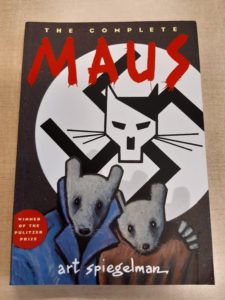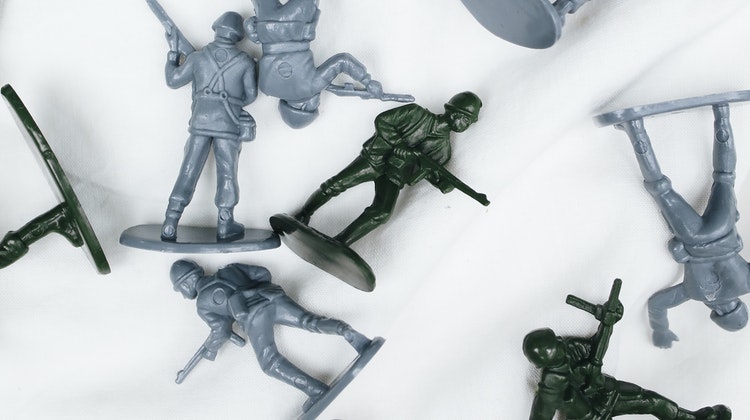Hi there!
As far as the history of the Second World War and the Holocaust/Shoa goes, I guess we all know something about it, like for example the nazi book burnings. But another truth is that what touches us the most about this part of history are the personal stories.
The graphic novel Maus, written and drawn by Art Spiegelman, is in my opinion one of those striking stories that teaches us about humanity and the Second World War, more than any history course can do.
I can start this review by telling you that Maus is a must read for everybody that’s interested in movies like Schindler’s List, The Boy in the striped pyjama’s, the Pianist and many more. Why am I so sure about this? Let me convince you in this review of the graphic novel Maus by Art Spiegelman, a deservedly Pulitzer Price winner.

What is Maus about?
Let me first tell you what Maus is about. This graphic novel was written and drawn by Art Spiegelman. The story is about his own family.
The main story line is his father telling Art the story of what he had to endure as a Jew during the Second World War and the Holocaust/Shoa. The fathers story starts a while before the outbreak of the war and even Nazism, so it also shows us the everyday life of a Jewish family the interbellum period.
The other story line, actually the origin of this graphic novel, is the relationship between Art Spiegelman and his father. And it’s fair to say that the relationship between the son, who is searching his own path in life while facing his own problems, and his dominant father is not that what you would call smooth.
Art Spiegelman starts to interview his father about the Holocaust/Shoa as a source for his new artwork, but these moments are also a way for them to grow a bit closer to each other.
Maus is a 3-part graphic novel and both story lines, the war and family relationships, are pretty raw and harsh but recognisable. The honesty of the depiction of the story lines, especially the personal ones, is one of the strengths of Maus. Art Spiegelman clearly gathered all of his courage to create this very personal novel that’s not only about his father. Maus is clearly also a form of therapy for the author himself.
Maus: a graphic novel with animals
One of the interesting things of this graphic novel, besides the story, is the depiction of the characters. Maus, which is a German word and means ‘mouse’, does not contain humans. No, all the characters are some kind of animal. That gives this graphic novel a bit the feel of a comic book. A very serious one that is not suited for children though.
The main characters, like the family of Spiegelman, are depicted like mice. Their arch enemy in this story, the nazi-soldiers, are naturally depicted like cats. But you can also spot some dogs, birds and other species in the artwork.

The other artwork of Maus
Besides the animals, the rest of the artwork in Maus is also worth a part in this review.
You can call the drawings themselves a bit raw, but, in my opinion, that just adds to the atmosphere of Maus. The story itself is raw and harsh and the drawings underline this throughout the whole comic book.
The graphic novel Maus is also completely drawn in black and white, which also contributes to the overall atmosphere.
The style of drawing and the lack of colour make it feel like this is artwork that was poured out by the author without to much redactional work to make it more perfect.
Conclusion: review of the graphic novel Maus by Art Spiegelman
I think that reading my review of the graphic novel Maus made it clear that I advise everyone who is interested in the history of the Second World War and the Holocaust/Shoa to read this three part comic book.
Art Spiegelman tells his family history in a very personal but straight manner. The fact that Maus contains so many story lines and in depth levels, Art Spiegelman himself, his father, the family relationships and of course the war, makes this graphic novel a very interesting read.
Where to buy the graphic novel Maus by Art Spiegelman
If you are planning to buy Art Spiegelmans graphic novel Maus, I would suggest buying a combined version with the three separate parts in one comic book.
You can’t really read the three comic books in a separate way, the story always continues before being concluded in the third book.
On the other hand, buying the three separate books may give you a breathing point in the story. It’s a pretty heavy family and war history, so being forced to take a break between the books may come in handy, instead of trying to read it as one big story.
So, depending on what kind of reader you are and how much you are personally affected by the history of the Second World War, the Holocaust/Shoa and hard family relationships, you can choose for the three comic books separately of the graphic novel combined in one edition.
For all who are going to read Maus: have a good read! And for those wo are interested in World Word 2 history: have you ever visited the Fuhrer bunker?
Source: Maus – graphic novel (for review purposes)





